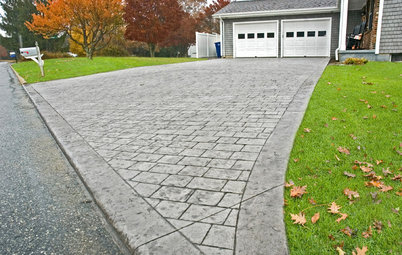A Guide to Using Limestone in the Patio
Limestone stands the test of time and works in both contemporary and classic landscape designs
Limestone has been used to construct some of the earliest forms of architecture all over the world. In today’s landscapes, limestone can be used to create an antique or old-world look, but it also is a great choice for contemporary patios and terraces. It’s available in many different colours, depending on where it is quarried.
Pros
French limestone pavers
- Wide range of colour and texture options available
- Light limestone colours deflect heat and stay cool on bare feet; useful in warm climates and around pools
- Extremely durable and long lived
- Heavy and expensive, making it difficult to use for DIY projects
- Sensitive to acids; acidic cleaners can erode the surface
French limestone pavers
Size and colour
Limestone comes in all sizes and shapes: Slabs, pavers, edging, wall veneer, capstone, stair treads and sizes for fountains and fire pits. Dimensioned stone and irregular flagstones are also available.
Most people associate limestone with creamy white tones, but the material has beautiful greys and blues that rival those of bluestone.
Finishes
Limestone can be honed to a smooth and consistent finish or have a thermal finish, which is a little more rough or uneven.
Sealing the stone is up you. Some homeowners like the look of unsealed stone, which works fine outside and will have a patina over time. If you do choose to seal the stone, check with your stone supplier for a sealer recommendation.
Shown
A pool deck paving of Eramosa limestone
Take a look at these 19 spectacular pools from around the world
Limestone comes in all sizes and shapes: Slabs, pavers, edging, wall veneer, capstone, stair treads and sizes for fountains and fire pits. Dimensioned stone and irregular flagstones are also available.
Most people associate limestone with creamy white tones, but the material has beautiful greys and blues that rival those of bluestone.
Finishes
Limestone can be honed to a smooth and consistent finish or have a thermal finish, which is a little more rough or uneven.
Sealing the stone is up you. Some homeowners like the look of unsealed stone, which works fine outside and will have a patina over time. If you do choose to seal the stone, check with your stone supplier for a sealer recommendation.
Shown
A pool deck paving of Eramosa limestone
Take a look at these 19 spectacular pools from around the world
Maintenance
Limestone is sensitive to acidic materials, so think twice before planting a fruit tree next to limestone paving; fallen fruit can decay and easily stain the limestone.
“Limestone should be cleaned gently using a mild cleanser that has been diluted with water,” says Hal McCullough of Maiden Stone Inc. in Houston, Texas. “Use a stiff bristled brush to scrub the surface. After scrubbing, simply rinse the limestone. Intense pressure washing is not recommended because it will damage the stone surface. Also, if you decide to use a sealant, you must continue to use the same product or sealer type for all future reapplications.”
Shown
Coeur d’Alene limestone paving
Limestone is sensitive to acidic materials, so think twice before planting a fruit tree next to limestone paving; fallen fruit can decay and easily stain the limestone.
“Limestone should be cleaned gently using a mild cleanser that has been diluted with water,” says Hal McCullough of Maiden Stone Inc. in Houston, Texas. “Use a stiff bristled brush to scrub the surface. After scrubbing, simply rinse the limestone. Intense pressure washing is not recommended because it will damage the stone surface. Also, if you decide to use a sealant, you must continue to use the same product or sealer type for all future reapplications.”
Shown
Coeur d’Alene limestone paving
Sustainability
Limestone comes in colours lighter than brick and concrete, which gives it a better solar reflectance index, or SRI. A high SRI means that the stones stay cool by reflecting sun and releasing thermal radiation, rather than absorbing it and heating up, reducing the heat-island effect around your home. Limestone is popular as a building material in warm climates because it stays cool to the touch.
Shown
French limestone fountain
6 native Indian flooring materials
Limestone comes in colours lighter than brick and concrete, which gives it a better solar reflectance index, or SRI. A high SRI means that the stones stay cool by reflecting sun and releasing thermal radiation, rather than absorbing it and heating up, reducing the heat-island effect around your home. Limestone is popular as a building material in warm climates because it stays cool to the touch.
Shown
French limestone fountain
6 native Indian flooring materials
This fountain and courtyard pool is made of cream-coloured limestone. The light coloured stone works beautifully with the gravel in a similar colour.
Browse through these mesmerising courtyards
Browse through these mesmerising courtyards
A contemporary flush-edge limestone pool deck. The grey colours are lovely against the changing autumn leaves in the landscape beyond.
Read more:
Guide: How to Choose the Best Floor for Your Porch
Tell us:
What material have you used in your patio? What are its benefits? Tell us in the Comments below.
Read more:
Guide: How to Choose the Best Floor for Your Porch
Tell us:
What material have you used in your patio? What are its benefits? Tell us in the Comments below.



















Limestone is a sedimentary rock with a typically grainy appearance. It’s quarried all over the world, and it comes in many colours, including blue, grey, tan and pinkish white. Limestone is a durable old-world stone with contemporary uses for high-end landscape projects.
Shown
Coeur d’Alene limestone paving